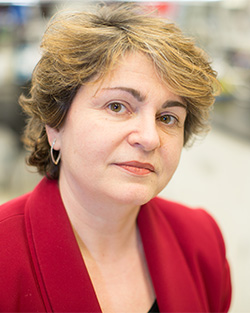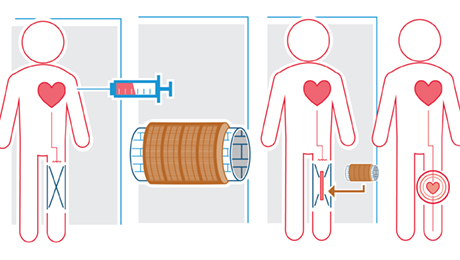Narine Sarvazyan and her team were trying to create universal-donor stem cells—cell transplants that the immune system would be less likely to reject—when something else caught her eye.
Observing a clump of cardiac muscle cells, called myocytes, she noticed that they were affecting blood flow in nearby vessels.
 “I thought: Why not just use these cells and wrap them around [a vein] and make a little pump?” said Dr. Sarvazyan, a professor of pharmacology and physiology in the George Washington University School of Medicine and Health Sciences.
“I thought: Why not just use these cells and wrap them around [a vein] and make a little pump?” said Dr. Sarvazyan, a professor of pharmacology and physiology in the George Washington University School of Medicine and Health Sciences.
The pump, essentially, would be a miniature heart—the kind of extremely simple circulation-aiding organ of which some worms, for example, have several.
The human heart is usually sufficient to circulate blood through the body. In the lower extremities, the movement of skeletal muscles helps squeeze veins, and valves ensure that pressure pushes blood only one way—back to the heart.
As people age, however, those valves often lose their efficacy and become one cause of blood pooling in the venous system. That pooling of the blood, called chronic venous insufficiency, can lead to varicose veins—which affect an estimated 25 percent of adults—as well as edema, ulcers, infections, or even amputations.
According to an article by Dr. Sarvazyan, published online in February in the Journal of Cardiovascular Pharmacology and Therapeutics, there are few treatment options at present, particularly when valves fail deep in the venous system.
Her idea could help treat the condition in a new way. Since groups of myocytes will spontaneously beat just as the heart does, tissue engineers could use a scaffold-like structure to build a rhythmically contracting piece of cardiac tissue from a patient’s own stem cells. This self-beating muscle then could be wrapped around veins with dysfunctional valves to help push blood back to what Dr. Sarvazyan jokingly calls “the big heart.”
The CardioVein technology, as it’s been dubbed, is still in its early stages, but Dr. Sarvazyan and her team have built a prototype to test the concept and last year filed a provisional patent.
Researchers elsewhere, working on “big heart” tissue repair, have already successfully grafted small pieces of cardiac muscle to live animals, where it became vascularized and continued to beat for months, she said.
“All the individual steps of this process already have been shown by ourselves or others,” she said. “So there are many indirect indications that [the concept] should work.”
The next step is to measure whether the cuff, wrapped around a vein, could produce sufficient pressure to aid circulation in a living animal. This summer Dr. Sarvazyan and her team will work on strengthening the cuffs and measuring the pressure and flow they are capable of producing. With sufficient funding, she says, they could begin testing in live animals within the year.
Until then, Dr. Sarvazyan has to divide her focus among multiple projects—including the stem cell research that first sparked her imagination. But the mini-heart idea might be the most revolutionary.
“It’s really exciting in its simplicity,” she said.
This story originally appeared in GW Research Magazine.


